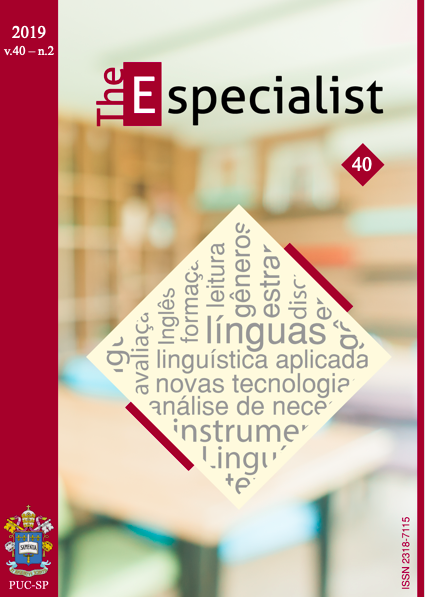Analyzing vocabulary activities in EFL textbooks*
DOI:
https://doi.org/10.23925/2318-7115.2019v40i2a7Palavras-chave:
Vocabulary, Reading, TextbooksResumo
EFL textbooks were analyzed to investigate the relationship between the reading units and the vocabulary activities. From the three textbooks analyzed, only textbook one has a clear relationship between reading and vocabulary. A framework was also developed to investigate several aspects regarding the vocabulary activities. The first aspect regards how vocabulary was approached, and results have shown that vocabulary appears in different ways. The second aspect concerns glossaries/dictionary use, which was found that activities from all textbooks could be used as glossaries, while only textbooks two encourage dictionary use. The third aspect regards word-frequency, and only textbook one had more high-frequency words. The fourth aspect concerns the number of opportunities to find words in the input, and, again, only textbook one did so. The last aspect examined the depth of processing of the activities, and it was found that most of them promote a shallow level of processing.
Referências
ALPTEKIN, C. ERÇETIN, G. 2009. Assessing the relationship of working memory to L2 reading: does the nature of comprehension process and reading span task make a difference? System, 37: 627-639.
ALPTEKIN, C. ERÇETIN, G. 2010. The role of L1 and L2 working memory in literal and inferential comprehension in L2 reading. Journal of Reading Research, 33.2: 206-219.
BADDELEY, A.D. 1990. Human Memory: Theory and Practice. Hove, Uk: Lawrence Erlbaum Associates Ltda.
CRAIK, F.I.M., & LOCKHART, R.S. 1972. Levels of Processing: a framework for memory research. Journal of Verbal Learning and Verbal Behavior, 11: 671-684.
DE AZEVEDO, B. 2018. Reading and vocabulary: analyzing vocabulary activities in EFL textbooks and undergraduate professors' and learners' perceptions on the role of vocabulary in reading comprehension. Master’s Thesis, English Graduate Program, Federal University of Santa Catarina. Available at: https://repositorio.ufsc.br/handle/123456789/188090 Acessed on Aug 19, 2018.
DE AZEVEDO, B. & TOMITCH, L.M.B. (in press). Uma abordagem de análise de livros didáticos de
língua estrangeira: estabelecendo relações entre leitura e léxico. Domínios da Lingu@agem.
DE AZEVEDO, B., PIRES, D.R., LORENSET, C.C., TUMOLO, C.H.S. 2017. Vocabulário em inglês como língua estrangeira: um breve estado da arte no brasil. Estudos Anglo Americanos, 46.2: 62-94.
GAGNÉ, E.D., YEKOVICH, C.W., & YEKOVICH, F.R. 1993. The cognitive psychology of school learning. New York: HarperCollins.
GRABE, W. 2009. Reading in a Second Language: Moving from Theory to Practice. New York: Cambridge University Press.
HAUGNES, N. & MAHER, B. 2009. North Star: Focus on reading and writing (Basic/Low Intermediate). White Plains, NY: Pearson Education Inc.
HULSTIJN, J. & LAUFER, B. (2001). Some empirical evidence for the involvement load hypothesis in vocabulary acquisition. Language Learning, 51.3: 539-558.
JOE, A. 1995. Text-based tasks and incidental vocabulary learning. Second Language Research, 11.2, 149-158.
LAUFER, B. 1990. Ease and difficulty in vocabulary learning: some teaching implications. Foreign Language Annals, 23.2: 147-155.
___________. 1992. How Much Lexis is Necessary for Reading Comprehension? Vocabulary and Applied Linguistics, 126-132.
___________. 2001. Reading, word-focused activities and incidental vocabulary acquisition in a second language. Prospect, 16.3, 44-54.
___________. 2003.Vocabulary Acquisition in a Second Language: do learners really acquire most vocabulary by Reading? Some empirical evidence. The Canadian Modern Language Review, 59.2, 567-588.
___________. 2017. The three ‘I’s of second language vocabulary learning: input, instruction, involvement. In E. HINKEL (Ed.), 2017, Handbook of research in second language teaching and learning, London: Routledge: volume III. pp. 343-354.
LAUFER, B. HULSTIJN, J. 2001. Incidental vocabulary acquisition in a second language: the construct of task-induced involvement. Applied Linguistics, 22.1: 1-26.
LAUFER, B. ROZOVSKI-ROITBLAT, B. 2015. Retention of new words: quantity of encounters, quality of task, and degree of knowledge. Language Teaching Research, 19. 6: 1-25.
MEARA, P. 1980. Vocabulary Acquisition: A Neglected Aspect of Language Learning. Language Teaching, 13.3-4: 221-246.
NATION, I.S.P. 1990. Teaching and Learning Vocabulary. New York: Newbury House.
____________. 2001. Learning Vocabulary in Another Language. Cambridge: Cambridge University Press.
____________. 2006a. How large a Vocabulary Is Needed for Reading and Listening? The Canadian Modern Language Review, 63.1: 59-82.
____________. 2006b. The BNC/COCA headword lists. Retrieved from: http://www.victoria.ac.nz/lals/about/staff/paul-nation#vocab-lists Acesso em 12 jun. 2017.
____________. 2014. How much input do you need to learn the most frequent 9,000 words? Reading in a Foreign Language, 26. 2: 1-16.
RICHARDS, J.C. 1976. The role of vocabulary teaching. TESOL Quarterly, 10.1: 77-89.
RICHARDS, J.C., & ECKSTUT-DIDIER, S. 2012. Strategic Reading 1. New York, NY: Cambridge University Press.
SÖKMEN, A. 1997. Current trends in teaching second language vocabulary. IN N. SCHMITT AND M. MCCARTHY (Eds.) 1997, Vocabulary Description, Acquisition and Pedagogy. Cambridge: Cambridge University Press. 1.ed. pp. 237-257.
STAHL, S. A., & NAGY, W. E. 2006. Teaching Word Meanings. Mahwah, New Jersey: Lawrence Erlbaum Associates Inc.
TOMITCH, L.M.B. 2009. O ensino de vocabulário em leitura na língua estrangeira: uma análise de materiais didáticos. In DIAS, R. CRISTÓVÃO, V. (Orgs.), 2009, O livro didático de língua estrangeira: múltiplas perspectivas. Campinas, SP: Mercado de Letras, pp. 121-148.
TUMOLO, C.H.S. 2007. Vocabulary and reading: teaching procedures in the ESP classroom. Linguagem & Ensino, 10.2: 477-502.
ZOU, D. (2017). Vocabulary acquisition through cloze exercises, sentence-writing and composition-writing: extending the evaluation component of The Involvement Load Hypothesis. Language Teaching Research, 21:1: 54-75.
Downloads
Publicado
Como Citar
Edição
Seção
Licença
Os autores concedem à revista todos os direitos autorais referentes aos trabalhos publicados. Os conceitos emitidos em artigos assinados são de absoluta e exclusiva responsabilidade de seus autores.


 Esta obra está licenciada com uma Licença
Esta obra está licenciada com uma Licença 

